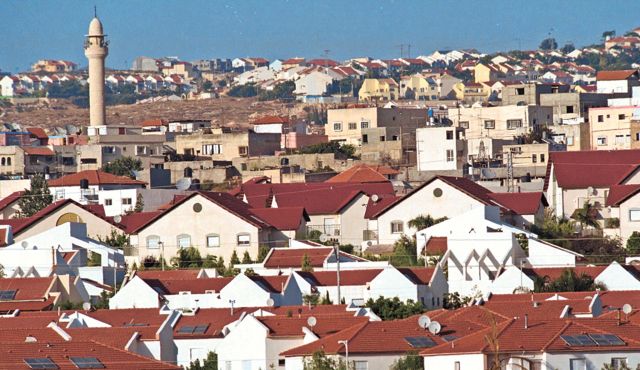Israel's West Bank settlements grew by twice the size of New York's Central Park in 2012
 Monday, May 27, 2013 at 11:11PM
Monday, May 27, 2013 at 11:11PM http://www.haaretz.com/news/diplomacy-defense/israel-s-west-bank-settlements-grew-by-twice-the-size-of-new-york-s-central-park-in-2012.premium-1.526101
By Chaim Levinson - Haaretz, 27 May 2013
 Israeli homes in the settlement of Matan. Behind them, the West Bank Palestinian village of Hableh. Photo by Avi Ohayon/GP
Israeli homes in the settlement of Matan. Behind them, the West Bank Palestinian village of Hableh. Photo by Avi Ohayon/GP
Legally controlled land grew from 530,931 to 538,303 dunams over the course of the year, a total increse of 7,32m dunams.
Israeli settlements in the West Bank legally expanded by nearly 8,000 dunams (1977 acres) in 2012 - land equaling the entire city of Bat Yam and twice as big as Manhattan's Central Park.
The adjustments were approved by military order, with the Israel Defense Forces' GOC Central Command granting settlement municipalities jurisdiction over the new territories.
Although in recent years the practice of giving large swathes of land to settlements has been abandoned, creeping annexations are still under way. In 2012, settlement-controlled land grew from 530,931 to 538,303 dunams, a total increase of 7,372 dunams, according to a comparison of maps from 2011 and 2012 at the Civil Administration offices.
Settlements can gain control of new land in one of two ways: either by laying claim to land identified in recent years by the so-called "blue-line team," which investigates the ownership of land within and around settlements to determine whether it is owned by Israel or private Palestinian citizens; and through the finalization of land acquisitions by Israeli citizens. Although that land is not inhabited by Palestinians, the act of increasing the settlement's jurisdiction paves the way for new construction projects and the expansion of existing settlements.
The settlement of Ofra, for example, which received 322 new dunams in 2012, includes a small piece of land purchased from Palestinians, as well as expropriated land and land on which the settlers have squatted. The new territory does not just correspond to existing construction in the settlement but includes expropriated land as well as purchased plots. However, all the roads leading to these plots go through private Palestinian-owned land, a fact the IDF’s announcement of the land grant failed to mention.
The state is now moving ahead on legalizing the existing homes in Ofra, as well as legalizing 100 housing units whose construction began without permits but was stopped by an interim order of the Supreme Court.
Among the other settlements that received additional land in 2012 are Ma’aleh Adumim, located east of Jerusalem and near the village of Isawiyah, which received 250 dunams; and the Kedumim Regional Council in the northern West Bank, which grew by 1,010 dunams after it was legally granted jurisdiction over the Bar-On industrial zone.
Kokhav Ya’akov received 66 dunams, land on which Givat Hayekev was built for evacuees of the Migron outpost.
The jurisdiction of the Rahelim and Nofei Nehemia settlements both swelled by 944 dunams, legalizing two outposts and paving the way for new construction in both. The Bruchin outpost was also legalized, after receiving 714 dunams. Elkana expanded by 904 dunams to the west, and Karnei Shomron grew by 300 dunams – where hundreds of housing units are to be built.
Changes were also made to the boundaries of the settlements Itamar and Shiloh, with the area of each increasing by 600 dunams. Beit El was given a bit of land at an adjacent army base to allow for the construction of 300 housing units, compensation for the court-ordered demolition of Givat Ulpana.
Smaller adjustments were made to a few other settlements: Eli Zahav, Har Gilo, Betar Ilit, Ma’aleh Amos, Pnei Hever, Sha'arei Tikva and Shadmot Mehola.
Researcher Dror Etkes, an expert on West Bank settlements, says that “While Israeli politicians like Prime Minister Benjamin Netanyahu have been blathering about their commitment to a two-state solution, the system is quietly and persistently grinding this concept into fine dust."
"If any more proof is needed, it should be noted that most of the municipal jurisdictional areas that were added to settlements over the last year were given to isolated settlements, which, it is clear, could never be attached to Israel in a two-state scenario,” Etkes said.
------------------------------------------------------------------------------------------------------------------------
 APJP |
APJP |  Post a Comment |
Post a Comment |